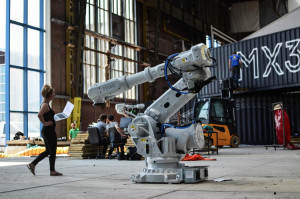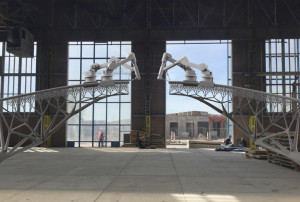 Dutch designer Joris Laarman has created a new research and development company called MX3D, which specializes in building six-axis robots that can 3-D print metal and resin in mid-air. In 2017 he will wheel a robot to the brink of a canal in Amsterdam. He’ll hit an “on” button. He’ll walk away. And when he comes back two months later, the Netherlands will have a new, one-of-a-kind bridge, 3-D printed in a steel arc over the waters. This isn’t some proof-of-concept, either: when it’s done, it will be as strong and as any other bridge. People will be able to walk back and forth over it for decades.
Dutch designer Joris Laarman has created a new research and development company called MX3D, which specializes in building six-axis robots that can 3-D print metal and resin in mid-air. In 2017 he will wheel a robot to the brink of a canal in Amsterdam. He’ll hit an “on” button. He’ll walk away. And when he comes back two months later, the Netherlands will have a new, one-of-a-kind bridge, 3-D printed in a steel arc over the waters. This isn’t some proof-of-concept, either: when it’s done, it will be as strong and as any other bridge. People will be able to walk back and forth over it for decades.
The tech allows for large-scale objects like infrastructure to be printed in the exact spot where they’ll live, which has radical implications for the construction industry and opens up a wealth of new design possibilities.
MX3D isn’t some high-tech concept; it actually works. In February 2014, Laarman showed off the MX3D system’s ability to 3-D print gravity-defying metal sculptures in mid-air. But printing out a bridge on location is a decidedly different challenge than 3-D printing something in a lab.
“We thought to ourselves: what is the most iconic thing we could print in public that would show off what our technology is capable of?” Laarman says in a phone interview. “This being the Netherlands, we decided a bridge over an old city canal was a pretty good choice. Not only is it good for publicity, but if MX3D can construct a bridge out of thin air, it can construct anything.”
The finished bridge will be around 24 feet long, support normal Amsterdam foot traffic, and feature a beautiful, intricate design that looks far more handcrafted than the detailing on most bridges. Because 3-D printing allows for a granular control of detail that industrial manufacturing does not, designs can be much more ornate, and almost bespoke in appearance.
Most 3-D printers use resin or plastic to construct objects. MX3D’s bridge will be made of a new steel composite that the University of Delft created. As strong as regular steel, it can be dolloped out by a 3-D printer, drop by drop. The result? A 3-D printed bridge as strong as any other, Laarman says.
As for the printer: it isn’t much like a Makerbot or any other desktop 3-D printer. For one thing, it has no printer bed. Instead, it works like a train. Except instead of running along existing tracks, it can actually print out its own tracks as it goes along. An additive printing technology that is more like welding than squirting out drops of plastic means that the tracks can go in any direction: not just horizontally, but vertically and diagonally as well. That allows the MX3D to cross gaps, like the empty space between walls, or the banks on a river, just by printing its way across them. A useful skill for a robot to have if it wants to 3-D print a bridge, or any other large structure, for that matter.
Laarman isn’t going this alone. He turned to architecture and engineering software company Autodesk to help give MX3D some much-needed smarts. According to Maurice Conti, head of Autodesk’s Applied Research Lab, Autodesk wanted to work with MX3D because it would help tackle other problems inherent to 3-D printing.
Take error control. Most 3-D printing occurs in a print bed under pretty stable conditions, but even so, mistakes happen. A drop of additive gets misplaced, and because the printer doesn’t know how to compensate for that, the next drop gets added to the wrong place, too. The results of such errors range from the comical to the Lovecraftian. Not exactly the kind of thing you want on a bridge that’s meant to handle foot traffic. Since the MX3D will be building in public, it needs to be able to compensate for a wide range of errors, from big fluxes in temperature that expand the metal to kids hurling beer bottles at the robot.
“Robots tend to assume that the universe is made of absolutes, even though that’s not true,” Conti says. “So we need to program them to have real-time feedback loops, and adapt in real-time, without even being told to.”
 That’s a big challenge, but one Autodesk thinks is worth solving. Not just because the advances would also be applicable to other types of 3-D printing, but also because it opens the door to an amazing future. “Imagine some day in the future, just going somewhere, dropping off a robot, and coming back two months later to have this huge piece of infrastructure there, without any human intervention at all!” Conti marvels. The MX3D bridge project is an opportunity for Autodesk to not just flex its artificial intelligence muscles, but to test the results in the real world.
That’s a big challenge, but one Autodesk thinks is worth solving. Not just because the advances would also be applicable to other types of 3-D printing, but also because it opens the door to an amazing future. “Imagine some day in the future, just going somewhere, dropping off a robot, and coming back two months later to have this huge piece of infrastructure there, without any human intervention at all!” Conti marvels. The MX3D bridge project is an opportunity for Autodesk to not just flex its artificial intelligence muscles, but to test the results in the real world.
When it’s built over the course of two months in fall of 2017, the MX3D’s finished bridge (it doesn’t have a name yet, and even the exact location is still being determined) will be the first step toward that future. If it works, who knows what’s next? Ten years from now, we might watch skyscrapers be built by massive 3-D printing cranes, lifting themselves up as they squirt massive industrial steel girders beneath themselves.
But the challenges ahead are also great. Despite teaming up with some of the best bridge engineering companies in the industry, and running lots of test, MX3D won’t know if their great plan will work until they actually do it. With two years to go before they’re ready, a lot is riding on their preparations, and their work with Autodesk…not least of which are the first people who actually walk over the first 3-D printed bridge in the world.



